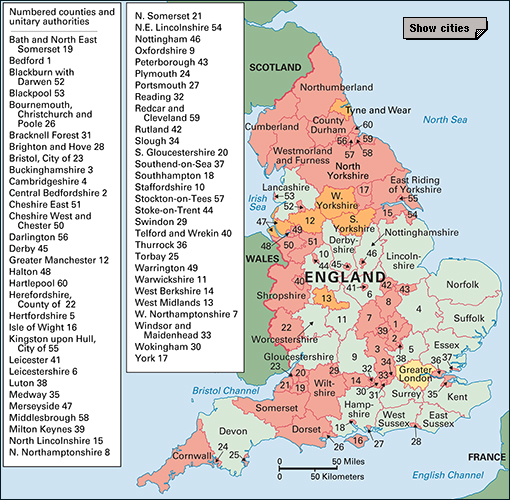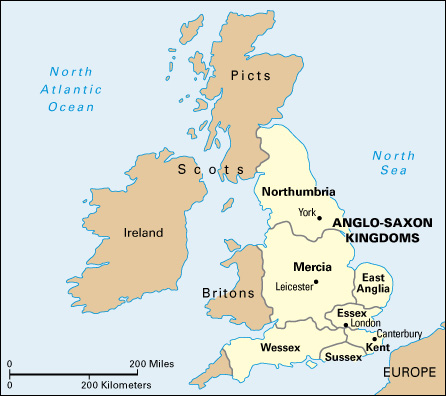Sussex is a large county on the southeastern coast of England. Crowds of vacationers flock to its seaside towns in summer. Most of the people of Sussex live close to the coast. Many of these people make the trip to London daily to work. One of the most famous battles in British history was fought in Sussex, near the town of Hastings, in 1066. At this battle, Duke William of Normandy led the last successful invasion of England and became King William I (the Conqueror).

Sussex is a geographical county and is divided into two separate administrative counties, East Sussex and West Sussex. Each has its own elected county council and administrative offices. The administrative center of East Sussex is Lewes. The administrative center of West Sussex is Chichester. East Sussex covers an area of 695 square miles (1,795 square kilometers). West Sussex has an area of 780 square miles (2,015 square kilometers).
Economy.
Manufacturing has become increasingly important to Sussex in recent years. Even the coastal resorts, where people traditionally rely on tourism for a living, have attracted some light industry. Products manufactured in Brighton and Hove, for example, include canoes, duplicating equipment, electrical equipment, and toys. Among the other goods produced by Sussex factories are aircraft components, books, bricks and tiles, clothing, cosmetics, plastics, and processed food.
Almost every kind of agriculture possible in the United Kingdom is carried on in Sussex. Farmers on the hills of the South Downs traditionally raise sheep, but many of them are now growing wheat instead. In East Sussex, near the Kent border, farmers grow hops for use in brewing, as well as potatoes and strawberries. On Romney Marsh, most of which is in Kent, farmers keep cattle and sheep.
Most parts of the county have mixed farming. There are herds of the dark red Sussex beef cattle in many places. Near the coast, farmers keep mainly dairy cattle. On the coastal plain, truck farming is widespread, and there are many greenhouses. Growers produce currants, flowers, gooseberries, plums, raspberries, strawberries, and tomatoes. The plain has many poultry farms, especially in East Sussex.
Miners in the county produce gypsum. The Chichester area has sand and gravel quarries.
Tourism is an important part of the Sussex economy, especially on the coast. Many opera lovers go to Glyndebourne, near Lewes, for the festival held there each summer.
Land.
Sussex is bordered on the north by Surrey, on the northeast by Kent, on the south by the English Channel, and on the west by Hampshire. The chalk hills of the South Downs stretch for more than 50 miles (80 kilometers) across the county, from northwest to southeast. They are highest in the northwest, where they rise to more than 800 feet (240 meters) above sea level. They terminate at Beachy Head, on the English Channel, in cliffs that are 530 feet (160 meters) high. The Downs slope gently on the south and steeply on the north, and are up to 6 miles (10 kilometers) wide.
The Weald, an area of clays and sandstones, lies between the North Downs in Kent and the South Downs in southern Sussex. The Weald rises to more than 800 feet (240 meters) at Crowborough Beacon, in the center of Ashdown Forest. The Sussex coastline stretches about 90 miles (140 kilometers). The sea has worn away some parts and built up other places. There are areas of submerged forest off the coast. The ancient cathedral of Selsey now lies submerged in the sea.
A plain lies between the South Downs and the sea. The widest part of the plain is in the west, but the plain narrows to a stretch of coarse gravel beach between Brighton and Hove and Eastbourne. Cliffs extend with interruptions from near Bognor Regis through Brighton and Hove to Eastbourne. There are marshes at Pevensey.
Most of the rivers rise in the Forest Ridges, a hilly area of the Weald. The Rother forms part of the boundary of Sussex and Kent. The river enters the sea near Rye. The Cuckmere rises near Heathfield and flows into the sea just west of Eastbourne. The Adur, Arun, and Ouse rivers flow through gaps in the South Downs to the English Channel.
History.
People settled along the coast of Sussex and in the valleys of the Arun and Rother rivers in prehistoric times. Archaeologists have found many remains of early settlers, who came from the mainland of Europe and lived on the South Downs. In 1993, archaeologists discovered the tibia (shinbone) of a prehistoric human ancestor at Boxgrove, near Chichester. Scientists believe the find to be about 500,000 years old, making it the earliest such find in the United Kingdom. Archaeologists have also found New Stone Age hill forts at St. Roche’s Hill, north of Chichester, and on Whitehawk Down, near Brighton and Hove; and Iron Age hill forts, such as Cissbury Ring, near Worthing.
The Roman emperor Claudius invaded Britain in A.D. 43. The king of the Regni, whose capital was at Chichester, made peace with the Romans, who built a fortress at Pevensey to resist attacks from the Saxons. Saxons continued their attacks on the Britons after the Romans left Britain. The Saxon leader Ella landed near Selsey in about A.D. 477. He established the kingdom of Sussex.

Wilfrid of Northumbria landed at Selsey in 681. He introduced Christianity to Sussex. The rulers of Wessex took control of Sussex in the 800’s. The Danes often invaded Sussex from after 900 until Canute became king in 1016. William the Conqueror landed at Pevensey and defeated the army of King Harold near Hastings in 1066.
A barons’ army, led by Simon de Montfort, defeated the army of King Henry III at Lewes in 1264. During the English Civil War (1642-1648), the county was divided. Winchelsea and Lewes supported Oliver Cromwell. Chichester and Rye supported King Charles I.
